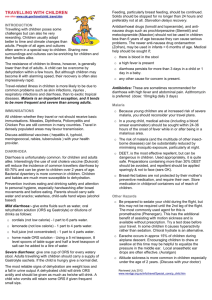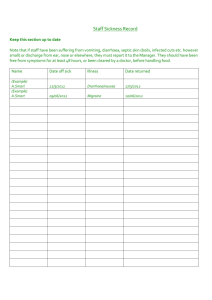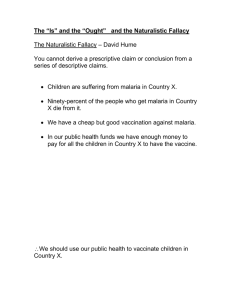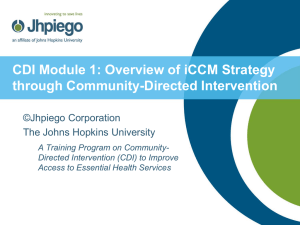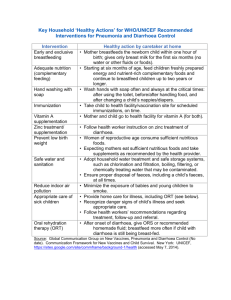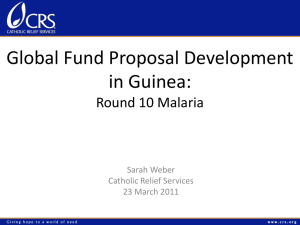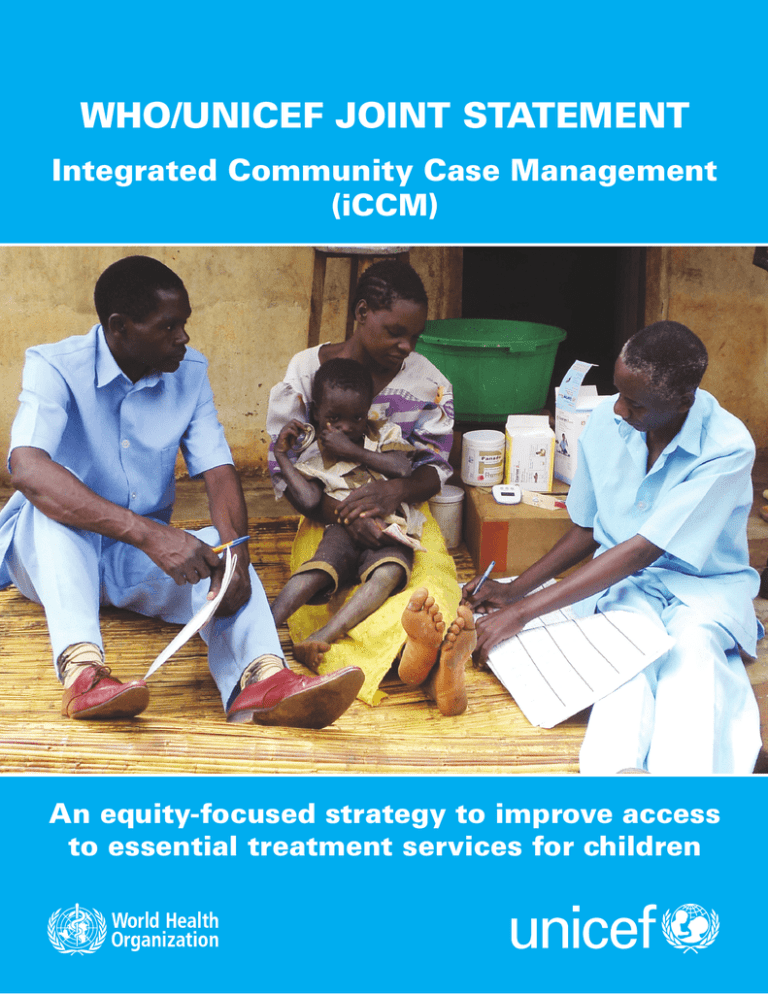
WHO/UNICEF JOINT STATEMENT
Integrated Community Case Management
(iCCM)
An equity-focused strategy to improve access
to essential treatment services for children
This statement presents the latest evidence for integrated community case
management (iCCM) of childhood illness, describes the necessary programme
elements and support tools for effective implementation, and lays out actions that
countries and partners can take to support the implementation of iCCM at scale.
Bringing treatment closer to home
Despite the progress made in reducing underfive mortality, three quarters of under-five deaths
are still due to a handful of causes – specifically,
pneumonia, diarrhoea, malaria and newborn
conditions. Malnutrition is associated with about
one third of the deaths.
The correct treatment of childhood pneumonia,
diarrhoea and malaria is one of the most powerful
interventions to reduce mortality.1 However, in
most high-mortality countries, facility-based
services alone do not provide adequate access to
treatment,2,3 and most importantly, not within the
crucial window of 24 hours after onset of symptoms. If child mortality is to be adequately addressed, the challenge of access must be taken on.
Community health workers – appropriately
trained, supervised and supported with an
uninterrupted supply of medicines and equipment
– can identify and correctly treat most children
who have the conditions mentioned above.4 In
2004, the World Health Organization (WHO) and
the United Nations Children’s Fund (UNICEF)
issued joint statements on the management of
pneumonia in community settings5 and the clinical
management of acute diarrhoea,6 both of which
highlighted the important role of communitybased treatment. A recent review by the Child
Health Epidemiology Reference Group (CHERG)
estimated that community management of all
cases of childhood pneumonia could result in a 70
per cent reduction in mortality from pneumonia in
children less than 5 years old.7 Community case
management (CCM) of malaria can reduce overall
and malaria-specific under-five mortality by 40
and 60 per cent, respectively, and severe malaria
morbidity by 53 per cent.8,9 Oral rehydration salts
(ORS) and zinc are effective against diarrhoea
mortality in home and community settings, with
ORS estimated to prevent 70 to 90 per cent of
deaths due to acute watery diarrhoea,10 and zinc
estimated to decrease diarrhoea mortality by 11.5
per cent.11
For these reasons, UNICEF, WHO and partners
working in an increasing number of countries
are supporting the iCCM strategy to train, supply
2
and supervise front-line workers to treat children
for both diarrhoea and pneumonia, as well as
for malaria in malaria-affected countries, using
ORS and zinc, oral antibiotics, and artemisininbased combination therapy (ACT). In addition,
the availability of high-quality rapid diagnostic
tests for malaria (RDTs) has made it possible to
test for malaria at the community level. RDT use
will make the need for high-quality integrated
treatment, including iCCM, even more pressing, to
ensure adequate health worker response to febrile
children with or without malaria. Finally, iCCM
also enables community health workers to identify
children with severe acute malnutrition through
the assessment of mid-upper-arm circumference
(MUAC).
Current context
The number of children dying worldwide continues to decrease, and while this is encouraging, the
decline has been slow, stagnating or even reversing in many countries, particularly in sub-Saharan
Africa. While new preventive interventions –
especially pneumococcal conjugate and rotavirus
vaccines – will also help reduce mortality, prompt
and effective treatment of pneumonia, diarrhoea
and malaria remains essential.
The delivery of health services is often weakest
where the needs are greatest, and low coverage of
the most needed interventions results in a significant unmet need for treatment of these major
child killers. In developing countries, current
treatment levels are unacceptably low:
•
Only 39 per cent of children receive correct treatment for diarrhoea.12
•
Only 30 per cent of children with suspected pneumonia receive an antibiotic.13
•
Less than 20 per cent of children with fever in
sub-Saharan Africa received a finger/heel stick for
malaria testing, in 11 out of 13 countries with available data in the region.14
Poor and disadvantaged children without access
to facility-based case management are at even
greater risk, as shown in the following figure.
Proportion of children aged 0–59 months with
diarrhoea receiving oral rehydration therapy*
with continued feeding, 2006–2011
Proportion of children aged 0–59 months with
suspected pneumonia receiving antibiotics,
2006–2011
100%
100%
80%
80%
60%
60%
48
40%
41
30
36
46
34
20%
0%
45
40%
Asia**
Developing
countries**
0%
25
19
20%
Africa
33
28
11
Africa
Notes: Estimates are based on a subset of 59 countries for ORT+CF and 34 countries for the antibiotics indicator, with wealth data for the period 2006–2011 covering 65 per cent and 50 per cent,
respectively, of the total under-five population in developing countries (excluding China, for which
comparable data are not available).
Asia**
Developing
countries**
Poorest 20%
Richest 20%
* Refers to ORS packets, recommended home-made fluids or increased fluids.
** Excludes China.
Source: UNICEF global databases, 2012.
Justification for iCCM
Programmatic experience shows that an integrated strategy can be effective in achieving high
treatment coverage and delivering high-quality
care to sick children in the community. In Nepal,
which has more than 20 years of experience in
community-based management of child illness,
69 per cent of the under-five population has access
to treatment,15 and both the case fatality rate for
acute diarrhoea and the proportion of severe
pneumonia among acute respiratory infection
cases across the country have decreased significantly.16 In Ghana, 92 per cent of caregivers of sick
children sought treatment from community-based
agents trained to manage pneumonia and malaria.
Indeed, most sought care for their children within
24 hours of onset of fever.17 In Zambia, a CCM
study on pneumonia and malaria found that 68
per cent of children with pneumonia received
early and appropriate treatment from community
health workers, and that overtreatment of malaria
significantly declined.18 In Ethiopia, workers
deployed in remote communities delivered two
and a half times as many treatments for the three
diseases than all the facility-based providers in the
same district.19 The proportion of children receiving ACTs globally is also increasing, although
significant gaps remain.20
With adequate training and supervision,
community health workers can retain the skills
and knowledge necessary to provide appropriate care. In Malawi, 68 per cent of classifications
of common illnesses by Health Surveillance
Assistants were in agreement with assessments
done by physicians, and 63 per cent of children
were prescribed appropriate medication.21
3
Community health workers improve access to treatment in underserved areas
Periphery of health centre’s
‘catchment area’, beyond which
CCM is needed.
Links between CHW
who provides CCM and
households
Link between supervisor
and CHWs who provide
CCM
Health centre with CHW supervisor and
store of medicine and supplies
Deploying community health workers can
increase coverage and access to treatment
Community health workers are an effective option
for investment as part of a comprehensive primary
health care system. However, community case
management should not be viewed as an inexpensive or low-cost measure. Effective implementation requires policy support, training, supervision,
performance maintenance and regular supplies. In
addition, community health workers are increasingly responsible for many health and development tasks, and expansion of their duties needs to
be carefully considered in this light.
Countries that decide to deploy community health
workers to increase coverage of iCCM should:
Examine the policy options: Existing policies may
need to be modified, or new policies put in place,
to allow non-medical community health workers
to administer antibiotics.
Build on existing programmes and initiatives: In
many countries, community-based programmes
for single diseases, such as malaria, have been
institutionalized and even scaled up. In these
cases, the experience gained from malaria
management can serve as a foundation to
which the case management of pneumonia and
diarrhoea can be added.
4
Ensure the quality of care: Community health
workers need support to maintain and enhance
their skills in assessing and managing child
illness. Refresher training should be undertaken
at periodic intervals, and supportive supervision
needs to be planned and carried out on a regular
basis. New approaches – such as peer supervision, clinical mentoring and the use of electronic
devices (e.g., cell phones and DVDs) – are being
used or tried out in some situations.
Ensure adequate and uninterrupted supplies and
medicines: It is critical that medicines for iCCM
meet the particular needs of young children and
their families, and that appropriate formulations,
dosages and packaging designed to improve
adherence are utilized. Coordinated efforts to
consolidate systems and support the supply chain
management function can be aided by a functioning logistics management information system.
Monitor and assess: A systematic approach to
gathering, aggregating, analysing and reporting data will serve to map and identify key gaps
in treatment coverage. Analysis of national and
sub-national data related to causes of death,
patterns of care-seeking, coverage of interventions, quality of care and other key indicators can
help identify where deployment of community
health workers for iCCM may be most effective.
Implementation support tools
Training in clinical skills: WHO and UNICEF
have developed an integrated package to train
community health workers to manage illness
in children 2 to 59 months of age. Integrated
Management of Childhood Illness: Caring for
Newborns and Children in the Community is
the ‘gold standard’ training package for iCCM.
The interventions require the use of four
low-cost medicines and one test: an antibiotic,
an antimalarial, ORS, zinc treatment and RDTs.
In addition, the guidelines support an assessment using the MUAC strip. The sequence to
be followed by the community health worker
is based on the principle that ‘one observation
leads to one action’, and does not depend on
individual judgment.
Programme management: The CORE Group
of non-governmental organizations (NGOs),
with support of the United States Agency for
International Development (USAID), published
Introduction to Community Case Management
Essentials: A guide for program managers,
which contains guidance for iCCM. WHO
produced a five-day training course, ‘Managing
Programmes to Improve Child Health’, which
includes CCM as a crucial ingredient in national
child health programming.
These and other tools are available online at
<www.CCMCentral.com>. This website, set up by
the global CCM Task Force, is a virtual resource
centre for iCCM tools and information, including
relevant publications and case studies.
Current treatment recommendations
c I f diarrhoea (less
than 14 days AND no
blood in stool)
c G
ive oral rehydration salts (ORS). Help caregiver give child ORS solution in front of you until child is no
longer thirsty.
c Give caregiver 2 ORS packets to take home. Advise to give as much as child wants, but at least 1/2 cup
of ORS solution after each loose stool.
c Give zinc supplement. Give 1 dose daily for 10 days:
c Age 2 to 6 months — 1/2 tablet (total 5 tabs)
c Age 6 months to 5 years — 1 tablet (total 10 tabs)
c I f fever (less than 7
days) in a malariaendemic area
c
c
c If fast breathing
c Give oral antibiotic (250 mg amoxicillin tablet).
Give twice daily for 5 days:
c Age 2 to 12 months — 1 tablet (total 10 tabs)
c Age 12 months to 5 years — 2 tablets (total 20 tabs)
o a rapid diagnostic test (RDT).
D
__Positive __Negative
If RDT is positive, give oral antimalarial artemether-lumefantrine (AL).
Give twice daily for 3 days:
c Age 2 months to 3 years — 1 tablet (total 6 tabs)
c Age 3 to 5 years — 2 tablets (total 12 tabs)
Source: Adapted from World Health Organization, Integrated Management of Childhood Illness: Caring for Newborns and Children in
the Community, WHO, Geneva, 2011.
One potential model for such an approach is
the Expanded Programme of Immunization’s
‘Reaching Every District’ strategy. Through
this approach, data on the number of children
receiving appropriate treatment for pneumonia,
diarrhoea and malaria could be made available to
respond to surges in the number of cases and to
assess performance, adjust strategies and monitor
supplies.
WHO, UNICEF and partners will support ministries
of health in all these steps
A systematic set of benchmarks is shown on page
6. These will, among other things, help identify
research priorities, determine the support needed
for operational and implementation research
activities, and document and disseminate good
practices from current and emerging iCCM
implementation.
5
Benchmarks for implementation
Country-level planning, implementation, monitoring and assessment of iCCM activities can be facilitated using a set of benchmarks (available at <www.CCMCentral.com>) that were developed by an interagency team.22 These benchmarks are organized according to eight system components, each of which
contains key activities and milestones to guide the process:
1.
Coordination and policymaking: Needs assessment and situation analysis for community-based
treatment services, including geographical mapping of communities suitable for iCCM; national
policies and guidelines in place to allow treatment at the community level; mapping of current
CCM activities and partners; and a national coordination mechanism for iCCM.
2.
Costing and financing: Costing exercise to ensure that necessary financing is secured.
3.
Human resources: Clear and well-articulated roles and expectations for community health
workers and communities; comprehensive basic and refresher training plan for community
health workers; and strategies for retention and motivation.
4.
upply chain management: Appropriate ‘child-friendly’ medicines and supplies for iCCM includS
ed in the national essential medicines list; and procurement plan, inventory control, resupply
logistics system and logistics management and information system (LMIS) for iCCM, with
standard operating procedures.
5.
Service delivery and referral: Appropriate guidelines for clinical assessment, diagnosis, management and referral, including plans for rational use of medicines (and RDTs where applicable);
and referral and counter-referral system for iCCM.
6.
Communication and social mobilization: Communication and social mobilization plan and strategy; and materials and messages for iCCM.
7.
Supervision and performance quality assurance: Plan and appropriate tools to support effective
supervision; trained supervisors; and resources (e.g., vehicles, fuel) to conduct supervision and
provide skills coaching to community health workers.
8.
Monitoring and evaluation and health information systems: Comprehensive monitoring
framework and system for all CCM components, integrated within the national health sector plan
and health information system; and operational research agenda for iCCM.
Conclusion
Accelerated action against the main child killers is
imperative as countries work to reduce the
under-five mortality rate by two thirds in order
to achieve the fourth Millennium Development
Goal by 2015. Action includes reaching out to
underserved populations to provide them with the
essential health services they need. Appropriately
trained and equipped community health workers,
6
provided with the necessary system supports,
can deliver iCCM for malaria, pneumonia and
diarrhoea as an effective intervention that
increases access to and availability of treatment
services for children. WHO and UNICEF support
iCCM as an essential strategy that can both foster
equity and contribute to sustained reduction in
child mortality.
References
1
Bryce, J., et al., ‘LiST as a Catalyst in Program Planning:
Experiences from Burkina Faso, Ghana and Malawi’,
International Journal of Epidemiology, vol. 39,
no. 1, 2010, pp. i40–i47.
12
United Nations Children Fund, The State of the World’s
Children 2012: Children in an urban world, UNICEF, New
York, 2012, p. 99.
13
Ibid.
2
Schellenberg, Joanna Armstrong, et al., ‘Inequities among
the Very Poor: Health care for children in rural southern
Tanzania’, Lancet, vol. 36, no. 9357, 2003, pp. 561–566.
14
Roll Bank Malaria Partnership, ‘A Decade of Partnership and Results’, Progress and Impact Series, Report 7,
Geneva, September 2011.
3
Victora, Cesar G., et al., ‘Applying an Equity Lens to Child
Health and Mortality: More of the same is not enough’,
Lancet, vol. 362, no. 9379, 2003, pp. 233–241.
15
4
Rowe, Samantha Y., et al., ‘Effect of Multiple Interventions
on Community Health Workers’ Adherence to Clinical
Guidelines in Siaya District, Kenya’, Transactions of the
Royal Society of Tropical Medicine and Hygiene, vol. 101,
no. 2, 2007, pp. 188–202.
16
Madhu, Ghimire, Yasho Vardhan Pradhan and Mahesh
Kumar Maskey, ‘Community-Based Interventions for
Diarrhoeal Diseases and Acute Respiratory Infections in
Nepal’, Bulletin of the World Health Organization, vol. 88,
no. 3, pp. 216–221.
5
World Health Organization and United Nations Children’s
Fund, ‘Management of Pneumonia in Community
Settings’, Joint statement, WHO and UNICEF, Geneva and
New York, 2004.
Dawson, P., et al., ‘From Research to National Expansion:
20 Years’ Experience of Community-Based Management
of Childhood Pneumonia in Nepal’, Bulletin of the World
Health Organization, vol. 86, no. 5, 2008, pp. 339–343.
17
Gyapong, Margareth, and Bertha Garshong, Lessons
Learned in Home Management of Malaria: Implementation
research in four African countries, WHO, Geneva, 2007.
6
World Health Organization and United Nations Children’s
Fund, ‘Clinical Management of Acute Diarrhoea’, Joint
statement, WHO and UNICEF, Geneva and New York, 2004.
18
Yeboah-Antwi, Kojo, et al., ‘Community Case Management
of Fever Due to Malaria and Pneumonia in Children under
Five in Zambia: A cluster randomized controlled trial’,
PLoS Medicine, vol. 7, no. 9, 2010.
7
Theodoratou, Evropi, et al., ‘The Effect of Case Management on Childhood Pneumonia Mortality in Developing
Countries’, International Journal of Epidemiology, vol. 39,
2010, pp. i155–i171.
8
9
Kidane, G., and R. H. Morrow, ‘Teaching Mothers to
Provide Home Treatment of Malaria in Tigray, Ethiopia:
A randomised trial’, Lancet, vol. 356, no. 9229, 2000, pp.
550–555.
Sirima, S. B., et al., ‘Early Treatment of Childhood Fevers
with Pre-packaged Antimalarial Drugs in the Home
Reduces Severe Malaria Morbidity in Burkina Faso’,
Tropical Medicine and International Health, vol. 8, no. 2,
2003, pp. 133–139.
10
Munos, M. K., C. L. Fischer Walker and R. E. Black, ‘The
Effect of Oral Rehydration Solution and Recommended
Home Fluids on Diarrhoea Mortality’, International Journal
of Epidemiology, vol. 39, 2010, pp. i75–i87.
19
Degefie, T., et al., ‘Community Case Management Improves
Use of Treatment for Childhood Diarrhea, Malaria and
Pneumonia in a Remote District in Ethiopia’s Oromiya
Region’, Ethiopian Journal of Health Development, vol. 23,
no. 2, 2009, pp. 120–126.
20
Roll Bank Malaria Partnership, ‘A Decade of Partnership and Results’, Progress and Impact Series, Report 7,
Geneva, September 2011.
21
Institute for International Programs, ’Quality of Care
Provided to Sick Children by Health Surveillance
Assistants in Malawi: Report on preliminary findings’,
Johns Hopkins University, Baltimore, Md., 2010.
22
McGorman, L., et al., ’A Health Systems Approach to
Community Case Management of Childhood Illness:
Methods and tools’, American Journal of Tropical Medicine
and Hygiene, going to press summer 2012.
11
Fischer Walker, C. L., and R. E. Black, ‘Zinc for the
Treatment of Diarrhoea: Effect on diarrhoea morbidity,
mortality and incidence of future episodes’, International
Journal of Epidemiology, vol. 39, 2010, pp. i63–i69.
7
This Joint Statement was developed under the guidance and leadership of UNICEF and WHO, through
a collaborative process of the global CCM Task Force. Drafts were reviewed by Save the Children and
USAID, and staff from both of these organizations provided significant inputs to the final version.
World Health Organization
Department of Maternal, Newborn, Child and
Adolescent Health (MCA)
20 Avenue Appia
1121 Geneva 27
Switzerland
Tel.: +41 22 791 3281
Fax: +41 22 701 4853
Email: mca.@who.int
www.who.int
United Nations Children’s Fund
Health Section, Programme Division
3 United Nations Plaza
New York, NY 10017
USA
Tel.: +1 212 326 7000
www.unicef.org
This Joint Statement is endorsed and supported by the following agencies:
Cover photo:
Community case management worker and supervisor with a mother and child in Kantenje village clinic in Ntchisi District,
Malawi. © Save the Children, Essau Mwale
© United Nations Children’s Fund
All rights reserved. Permission is required to reproduce any part of this publication. Permission will be granted at no cost
to educational or non-profit organizations. Others will be requested to pay a small fee. Please contact UNICEF, Division of
Communication (email: nyhqdoc.permit@unicef.org, tel.: +1 212 326 7434).
June 2012

